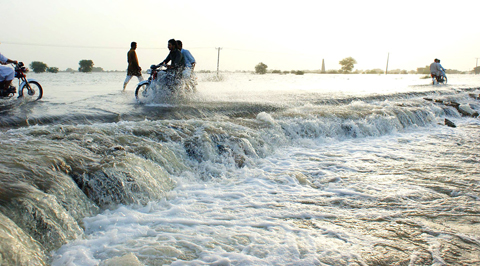The UN asked member states on Friday for US$2 billion to help Pakistan recover from massive floods that have displaced millions of people, the largest natural disaster appeal in UN history.
The appeal folds in an Aug. 11 call for US$460 million. The money is intended to cover the needs of up to 14 million people for the next 12 months, the UN Office for the Coordination of Humanitarian Affairs (OCHA) said in a statement.
“We must also do our part,” UN humanitarian chief Valerie Amos said. “We simply cannot stand by and watch the immense suffering in a disaster of this scale.”

PHOTO: EPA
She told reporters that 80 percent of the US$460 million in emergency aid requested by the UN for Pakistan last month had been received.
OCHA said the revised appeal to the 192 UN member states covers humanitarian and recovery needs for Pakistan, including projects in agriculture, community restoration, education, health and shelter.
Previously, the largest UN disaster aid appeal was US$1.5 billion for Haiti after a massive earthquake hit the Caribbean state in January.
Separately, the UN mission of Pakistan’s neighbor and rival, India, announced it had given the UN US$20 million to be used in the Pakistan relief efforts.
Last month, India donated US$5 million for the relief effort. Pakistan hesitated for several days before agreeing to accept that donation, which Islamabad said should go through the UN.
The two nuclear powers, which have fought several wars, continue to have an uneasy relationship. India accuses Pakistan of fueling unrest in the disputed Kashmir region, but Islamabad says it only lends moral support to what it calls Kashmir’s independence movement.
The floods in Pakistan began more than a month ago and swept through the country, leaving an area almost the size of England under water. OCHA said the floods have affected more than 20 million people, damaged or destroyed nearly 1.9 million homes and killed 1,700 people.
OCHA said Pakistan’s development prospects may be disrupted for years.
“The damage to the economic infrastructure and livelihoods is immense,” the statement said. “Irrigation, drainage and storage facilities are badly affected.”
Farmers who lost their crops and who are not able to plant their fields by November will likely remain dependent on aid until well into 2012, while hundreds of thousands more people lost their shops or other small businesses, it added.
“We are seeing the equivalent of a new disaster every few days in Pakistan,” Amos said. “Yesterday, new breaches of the embankments of Manchar Lake in Sindh flooded more villages. Millions of people have lost everything.”
Although the water is beginning to recede, large areas remain submerged and some villages in the southern province of Sindh are facing floods as the Indus River, swollen by heavy monsoon rains, flows south to the Arabian Sea.

Former Nicaraguan president Violeta Chamorro, who brought peace to Nicaragua after years of war and was the first woman elected president in the Americas, died on Saturday at the age of 95, her family said. Chamorro, who ruled the poor Central American country from 1990 to 1997, “died in peace, surrounded by the affection and love of her children,” said a statement issued by her four children. As president, Chamorro ended a civil war that had raged for much of the 1980s as US-backed rebels known as the “Contras” fought the leftist Sandinista government. That conflict made Nicaragua one of

COMPETITION: The US and Russia make up about 90 percent of the world stockpile and are adding new versions, while China’s nuclear force is steadily rising, SIPRI said Most of the world’s nuclear-armed states continued to modernize their arsenals last year, setting the stage for a new nuclear arms race, the Stockholm International Peace Research Institute (SIPRI) said yesterday. Nuclear powers including the US and Russia — which account for about 90 percent of the world’s stockpile — had spent time last year “upgrading existing weapons and adding newer versions,” researchers said. Since the end of the Cold War, old warheads have generally been dismantled quicker than new ones have been deployed, resulting in a decrease in the overall number of warheads. However, SIPRI said that the trend was likely

BOMBARDMENT: Moscow sent more than 440 drones and 32 missiles, Volodymyr Zelenskiy said, in ‘one of the most terrifying strikes’ on the capital in recent months A nighttime Russian missile and drone bombardment of Ukraine killed at least 15 people and injured 116 while they slept in their homes, local officials said yesterday, with the main barrage centering on the capital, Kyiv. Kyiv City Military Administration head Tymur Tkachenko said 14 people were killed and 99 were injured as explosions echoed across the city for hours during the night. The bombardment demolished a nine-story residential building, destroying dozens of apartments. Emergency workers were at the scene to rescue people from under the rubble. Russia flung more than 440 drones and 32 missiles at Ukraine, Ukrainian President Volodymyr Zelenskiy

Indonesia’s Mount Lewotobi Laki-Laki yesterday erupted again with giant ash and smoke plumes after forcing evacuations of villages and flight cancelations, including to and from the resort island of Bali. Several eruptions sent ash up to 5km into the sky on Tuesday evening to yesterday afternoon. An eruption on Tuesday afternoon sent thick, gray clouds 10km into the sky that expanded into a mushroom-shaped ash cloud visible as much as 150km kilometers away. The eruption alert was raised on Tuesday to the highest level and the danger zone where people are recommended to leave was expanded to 8km from the crater. Officers also